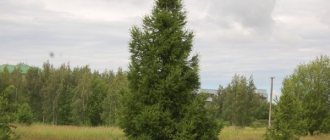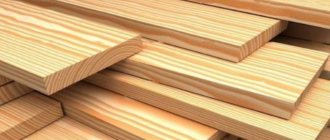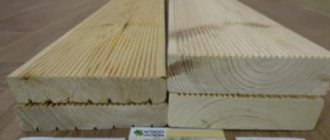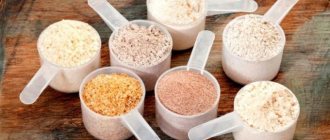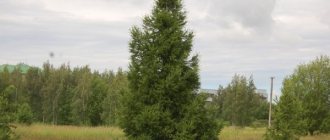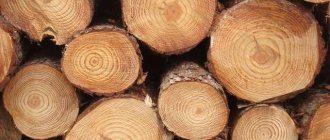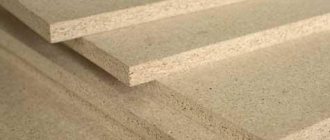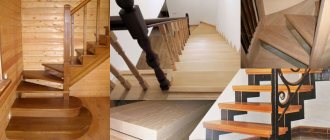Properties and characteristics
Larch wood is stronger than oak and is 96 MPa by 94 MPa with almost the same density. A distinctive feature of larch wood is also its characteristic structure and beautiful color.
In terms of structure, larch belongs to the soundwood species. Its heartwood has a reddish color, and the sapwood is presented in the form of a narrow strip with clear contours of white or yellowish color. The growth rings are clearly visible, and the boundary between early and late wood is clearly defined. The wood has a beautiful texture. The reason for this is the different colors of the heartwood and sapwood parts of larch, as well as the fact that there are very few knots in its structure.
Larch wood coloring
It has uneven density, which is due to the large difference in the density of the layers of early and late wood. Dense larch wood when freshly cut has a water absorption of 126%. Depending on the time of year and time of day, the humidity of a growing tree changes its values. True, in a small range, the reason for which is again the high density.
The low water absorption values of larch make it possible to use its wood for the manufacture of high-quality parquet boards. Larch tends to significantly reduce its volume after drying. Due to the low water conductivity of wood, the drying process itself differs from the drying of other types of wood. Larch warps and cracks during drying because internal stress increases greatly.
The climatic conditions in which a tree grows also affects the physical properties of the wood. So, for example, larch grown in the European climate has a much lower density than that grown in Altai or the Urals.
It is almost impossible to impregnate larch wood with any protective properties. This is due to high density and low air and moisture conductivity.
The physical and mechanical properties of deciduous wood allow it to be used in many ways. The processing technology is specific. It is very heavily impregnated with resins, and when sawing you have to often clean the saw blades of resin. Before painting and sanding finished larch products, the top layer must be degreased and cleared of resin, otherwise it will not be possible to obtain the desired result. But after cleaning the resin, larch wood can easily be painted and polished.
Larch wood has unique properties for which it is especially valued, the most important of which are:
- Larch has a very high resistance to fungal diseases and other biological damage. Moreover, the most biological stability is observed in the lower root part of the trunk.
- The resin with which larch is impregnated has very strong bactericidal properties. Now pharmacies have begun to sell it as “larch sulfur,” but earlier, and in some places even now, people willingly collected it and melted it, obtaining an unusually aromatic and healthy “chewing” gum. But that's not the main point. Due to this resin, the tree does not require chemical treatment to prevent damage from harmful insects.
- Under prolonged exposure to water, the hardness of larch increases, and the tree acquires the hardness of stone. At the same time, the time the tree spends in water also increases its strength. In Venice and Amsterdam, houses stand directly in the water on foundations made of larch piles. That is, without any reservations, we can say that this tree gains strength over the years and has passed the test of time for more than a thousand years.
- Its fire resistance is much higher in comparison with other conifers. So, in relation to pine, this figure is 2 times higher.
Varieties of larch flowers
Among all the coniferous tree species harvested in Russia, larch is clearly the leader in its physical, mechanical and decorative properties, and within its Russian varieties, Dahurian larch is considered the most valuable. It is superior to other types in terms of strength and decorative characteristics. The trunks grow to a height of more than 45 meters, and the stemness is 1.2%.
Types and varieties of larch
As already indicated, more than 20 species of this coniferous tree are known. We will not list all of them; we will consider only the 4 most common varieties:
- Daurskaya. The most common type in Russia – it accounts for approximately 85%. The most frost-resistant representative among larches, it grows on any soil, except in flooded areas.
- Siberian. Its share accounts for approximately 13-14%. It has distinctive features - the branches extend from the trunk at right angles, and at the ends they have a smooth upward bend. It also grows well in urban areas, which allows the variety to be used as green space in urban areas. This variety is most often used in medicine; almost all parts of the tree are used.
- European (ordinary). Most common in central and western Europe. Among all species, it is considered the tallest - in the Alps there are specimens over 50 meters high and with a trunk diameter of about two meters. True, in Russian conditions this species rarely grows above 25 meters. Widely used in medicine, in Russia also for decorative purposes.
- Japanese or camper. It was first described in Japan, although it also grows in Korea. Up to 35 m in height. A special feature is the coloring of the autumn needles in a bright yellow color. Most often used for decorative purposes.
Areas of use of larch wood
The remarkable properties of larch wood are the reason for its wide range of industrial uses. Construction, shipbuilding, production of musical instruments, production of parquet, laminated veneer lumber, sleepers in the construction of railway tracks, power poles - it is impossible to list all the possibilities for using this wood.
Larch in historical buildings
- In the palace of Count Sheremetyev there is larch parquet.
- In Moscow, in the Kremlin cathedrals and St. Basil's Cathedral, as well as in the Winter Palace of St. Petersburg, window frames and ceilings were made from it.
- Olympic cycling track in Krylatskoye - the tracks are built of larch.
- Larch was used in the manufacture of an organ in Kazimierz (Poland) back in the 17th century, due to the high acoustic properties of its wood.
- In the city of Zagorsk, a handmade ladle has been preserved, which was hollowed out from a larch root. The wood of its root system is the most decorative. The size of the roots is amazing. So, this ladle, which is hollowed out from a root, has a volume of more than 15 liters.
- Underwater piles on which buildings stand in Venice and Amsterdam.
Areas of use
Durable wood is classified as an elite species. Valuable raw materials are not destroyed by atmospheric agents, mold and insects, and their antiseptic properties are appropriate in medicine. Due to the characteristics of larch, the tree is used in various fields.
Furniture and utensils
Due to its high density, the dried material absorbs almost no water. The characteristics are appropriate when creating furniture that will be located in damp conditions. Interior items for baths and saunas do not crack due to temperature changes and constant moisture. Larch is used to make beautiful garden benches and tables.
Barrels made of strong wood are popular in winemaking. The parameters of the structures are not inferior to oak containers. Dense tanks are used for aging and long-term storage of elite alcoholic beverages.
Construction
Larch lumber is expensive, but very durable and strong. Construction raw materials can withstand any load, which is justified when creating ceilings (beams). Wood produces high-quality window and door blocks.
Profile beams and rounded logs are used in the construction of wooden houses and baths. When in contact with moisture, wood turns to stone, which is why it is used for pile buildings. Elements made of larch are appropriate when decorating spaces near swimming pools or the shores of bodies of water. Beams are not inferior in strength to metal profiles, so they are used in the construction of terraces and verandas.
Structure made of strong wood Source elgros.rf
Lining
Lightweight material is used for interior and exterior decoration. The wood has a beautiful light pattern that will make the room optically larger and more spacious. Popular types of raw materials:
- block house;
- brushed board;
- eurolining;
- calm.
European (regular)
European larch is considered the largest species - the height of the tree can reach 50 meters (such impressive specimens are especially common in the Alps), and the trunk thickness is often 2 meters. In the Russian climate, height indicators are more modest; the tallest specimens are usually no higher than 25 meters. The crown has a conical shape, and the needles are very delicate and completely non-thorny. The tree's flowering periods begin at the age of 15-20 years, with flowers appearing only in May. By autumn, cones ripen on European larch, but they will open only with the onset of spring. Young cones have an interesting bright red hue, reminiscent of miniature roses, while mature ones turn brown.
The European species is actively used in medicine; pine needles and resin (resin), which are characterized by a high level of essential oils, are especially often used as medicines.
Larch in folk medicine
Any items made from Siberian larch have the natural ability to purify the air and rid it of harmful volatile substances. Phytoncides contained in wood help the body cope with colds. They also actively destroy viruses, calm the nervous system and relieve migraines. Hypertensive and hypotensive patients are recommended to decorate the interior of their home with larch or at least have several items made from this wood.
The needles of this species are very rich in ascorbic acid. An infusion of fresh needles is used as an excellent remedy for scurvy, as well as for the prevention of various diseases and strengthening the immune system. Siberian larch is able to give Siberian health.
Baths made from larch needles are also very useful. They help those who suffer from joint diseases. Turpentine is a medicine against gout and rheumatism, which is made from larch resin.
